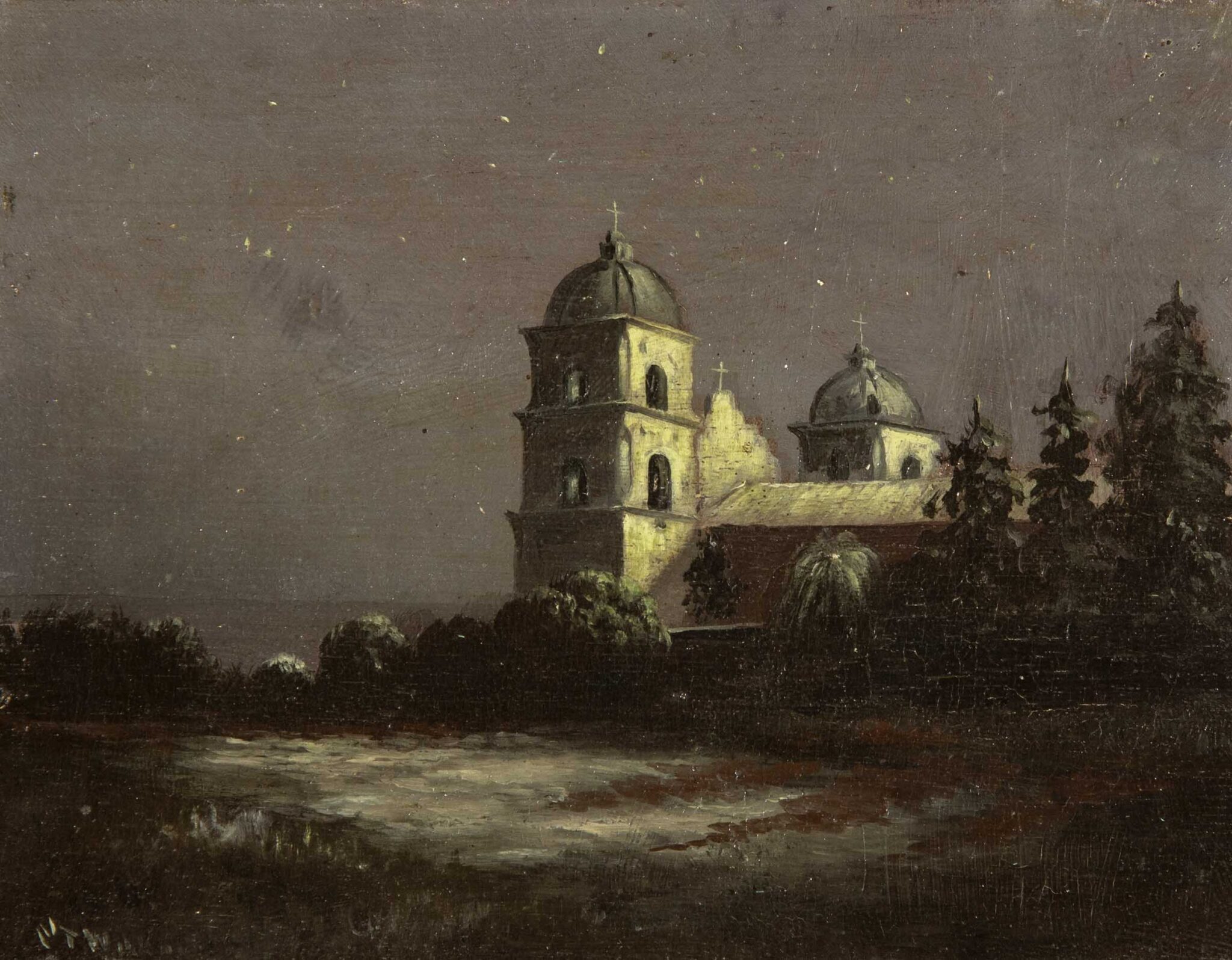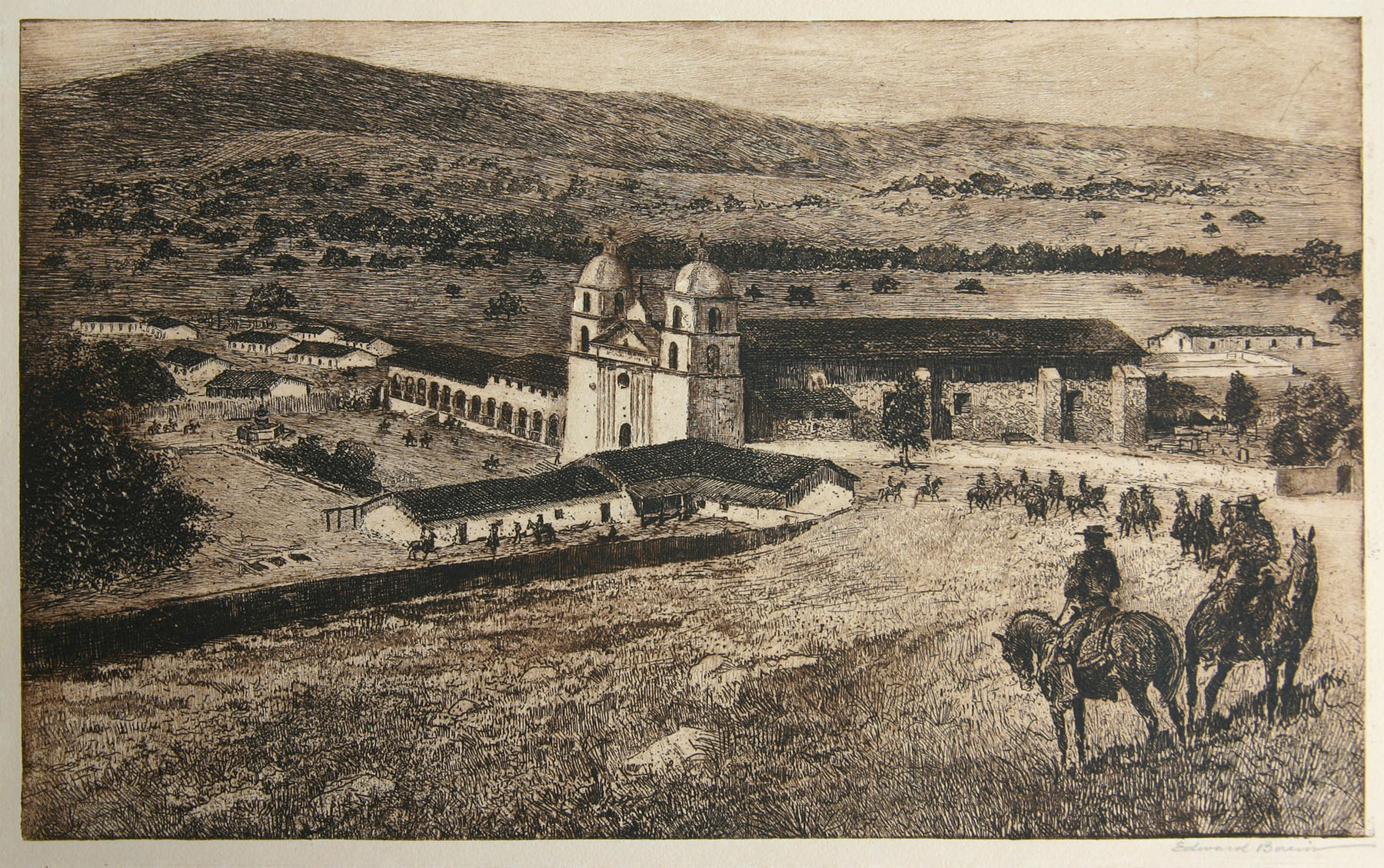
Borein, EdwardAmerican, 1872-1945
Mission Santa Barbara, No. 1, n.d
Etching and drypoint on paper
Edward Borein is ranked among the finest artists of the American West, noteworthy for his attention to detail and accuracy in portraying Native American cultures and cowboy life. Borein settled in Santa Barbara in 1921 and over the years executed a number works of the California missions including Mission Santa Barbara. Here he renders the Mission as it would have looked in the early 1860s. Note the vaqueros to the right and the quarters for the majordomo and tanner in front of the Mission.
Gift of the Estate of Thomas More Storke
12.80.66.3
Mission Santa Barbara, No. 1, n.d
Etching and drypoint on paper
Edward Borein is ranked among the finest artists of the American West, noteworthy for his attention to detail and accuracy in portraying Native American cultures and cowboy life. Borein settled in Santa Barbara in 1921 and over the years executed a number works of the California missions including Mission Santa Barbara. Here he renders the Mission as it would have looked in the early 1860s. Note the vaqueros to the right and the quarters for the majordomo and tanner in front of the Mission.
Gift of the Estate of Thomas More Storke
12.80.66.3

Moran, PeterEnglish, 1841-1914
Santa Barbara Mission Founded 1786, n.d.
Etching and drypoint on paper
Artistic talent ran in Peter Moran’s family; both of his brothers, Thomas and Edward, were painters. Peter and his family emmigrated from England to the U.S. in 1844. Beginning as a painter he took up etching in 1874. He became best known for his Romantic landscapes. As in this etching he often included animals in his works. Moran was also celebrated for his depictions of Native American cultures of the American Southwest.
Gift of the Estate of Florence H. Fernald
00.9
Santa Barbara Mission Founded 1786, n.d.
Etching and drypoint on paper
Artistic talent ran in Peter Moran’s family; both of his brothers, Thomas and Edward, were painters. Peter and his family emmigrated from England to the U.S. in 1844. Beginning as a painter he took up etching in 1874. He became best known for his Romantic landscapes. As in this etching he often included animals in his works. Moran was also celebrated for his depictions of Native American cultures of the American Southwest.
Gift of the Estate of Florence H. Fernald
00.9
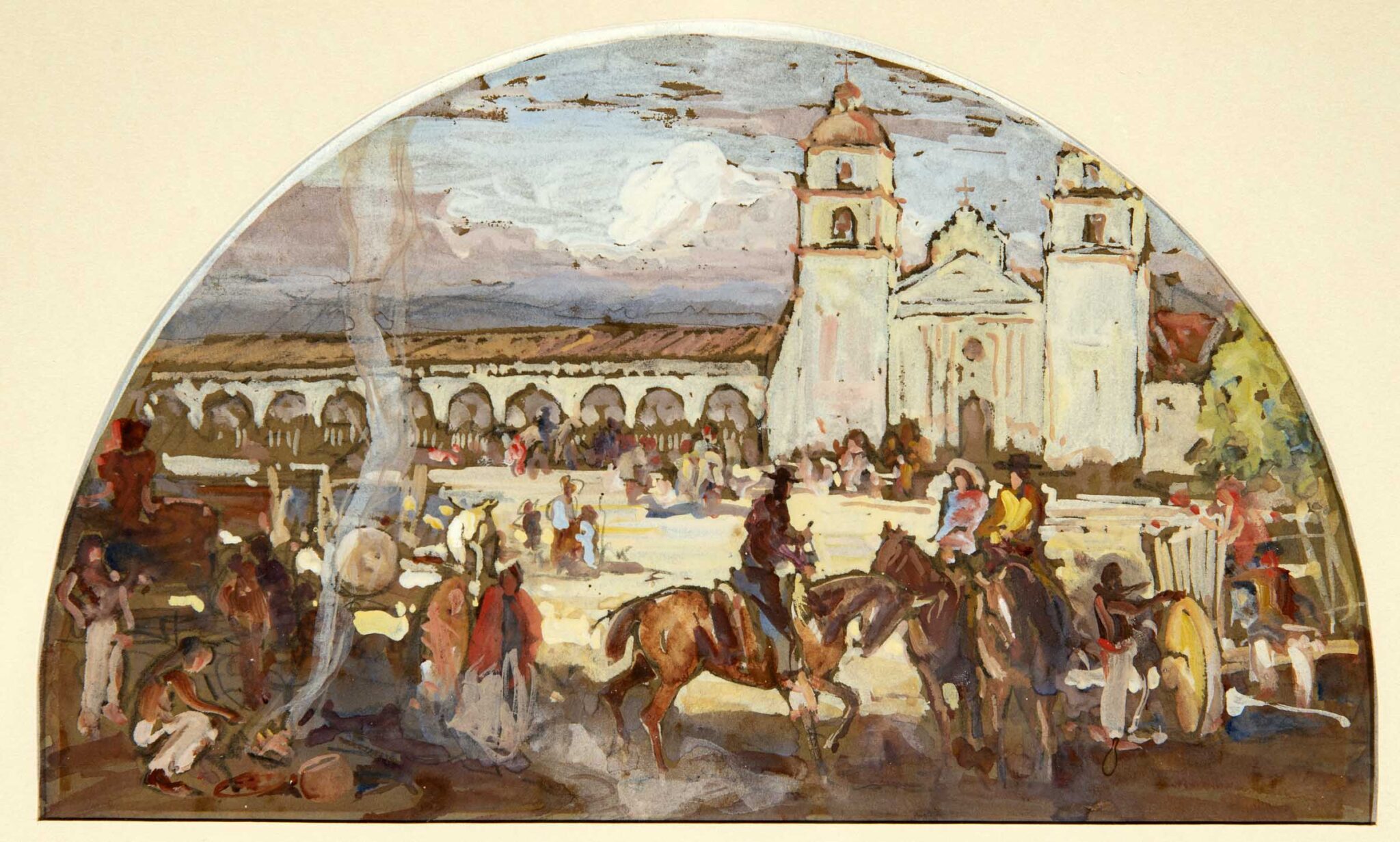
Borg, Carl OscarSwedish, 1879-1947
Santa Barbara Mission, (Study for a Mural), n.d.
Watercolor and gouache on paper
This native of Sweden immigrated to the U.S. in 1901 and within a few years he had made his way to California. Borg lived in Santa Barbara from 1918 to 1930, where he became good friends with cowboy artist Ed Borein and landscape painter Fernand Lungren, then returned here in 1945. Borg traveled extensively in California and the Southwest; the natural beauty of these areas and the cultures of Native Americans became primary subject matter for his art. This study for a proposed mural was meant for the Central Bank in Santa Barbara to be executed in partnership with Ed Borein; it was never completed.
Gift of Lily Borg Elmberg
x.9.77.3
Santa Barbara Mission, (Study for a Mural), n.d.
Watercolor and gouache on paper
This native of Sweden immigrated to the U.S. in 1901 and within a few years he had made his way to California. Borg lived in Santa Barbara from 1918 to 1930, where he became good friends with cowboy artist Ed Borein and landscape painter Fernand Lungren, then returned here in 1945. Borg traveled extensively in California and the Southwest; the natural beauty of these areas and the cultures of Native Americans became primary subject matter for his art. This study for a proposed mural was meant for the Central Bank in Santa Barbara to be executed in partnership with Ed Borein; it was never completed.
Gift of Lily Borg Elmberg
x.9.77.3
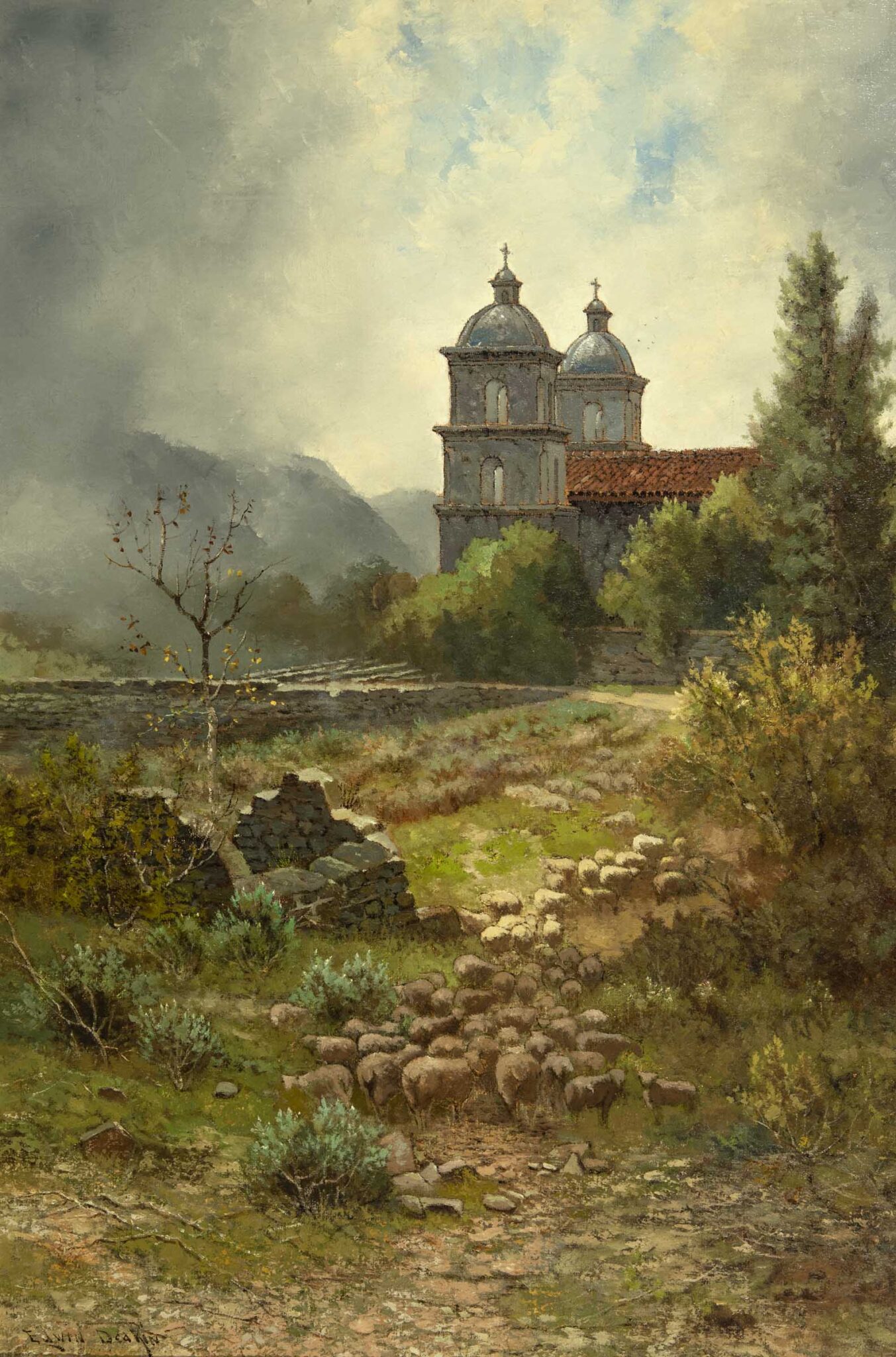
Deakin, EdwinEnglish, 1838-1923
A Pastoral Santa Barbara Mission California
c. 1890
Oil on canvas
Deakin chose a different perspective of Mission Santa Barbara for this oil. It was not until after he moved to Berkeley in the San Francisco East Bay area in 1890 that Deakin began concentrating on his California mission suites.
Museum Acquisition Fund
1991.165.1
A Pastoral Santa Barbara Mission California
c. 1890
Oil on canvas
Deakin chose a different perspective of Mission Santa Barbara for this oil. It was not until after he moved to Berkeley in the San Francisco East Bay area in 1890 that Deakin began concentrating on his California mission suites.
Museum Acquisition Fund
1991.165.1
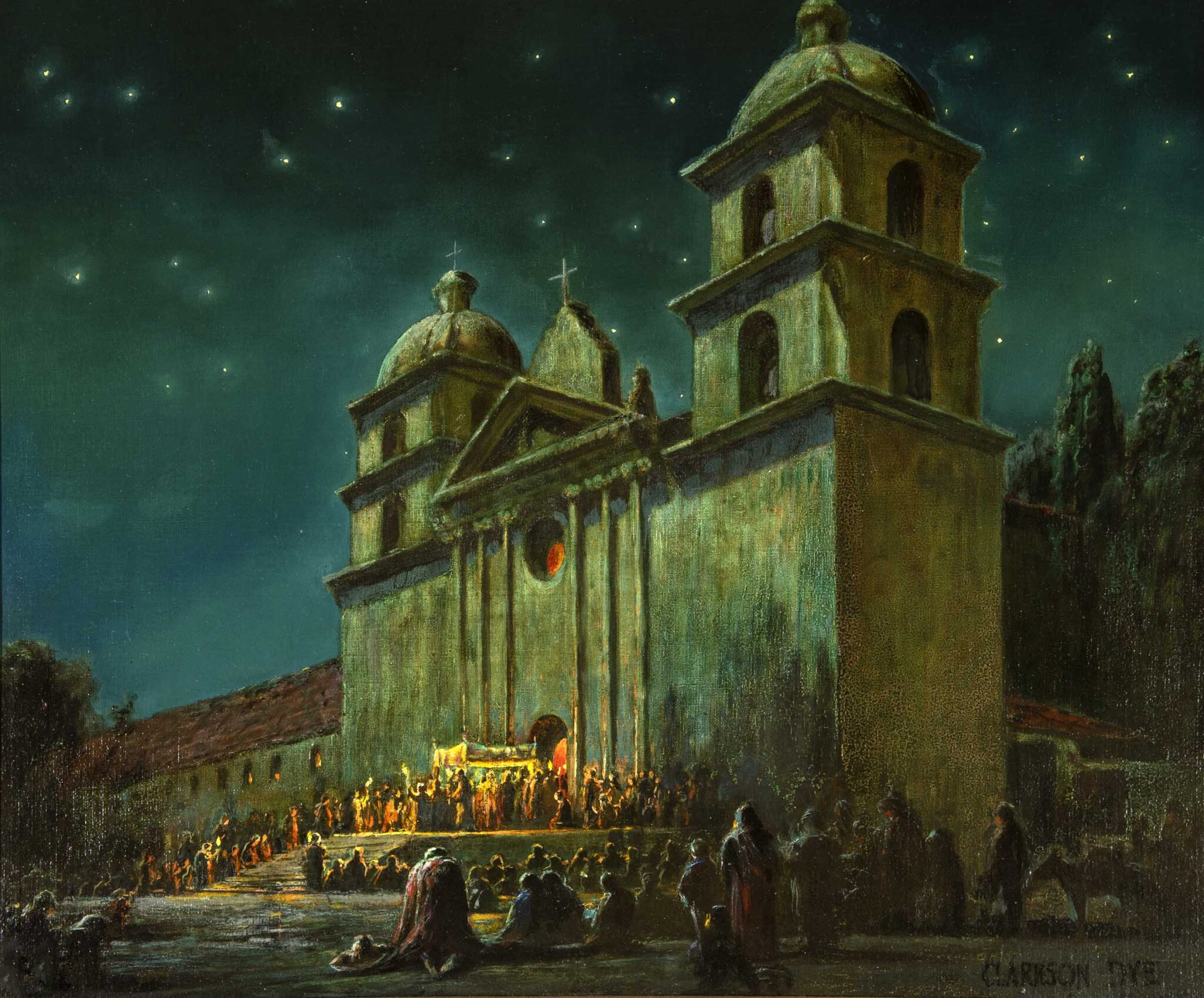
Dye, ClarksonAmerican, 1869-1955
Santa Barbara Mission - A Ceremony of the Old Days in the Past, n.d.
Oil on canvas
Clarkson Dye was born and lived most of his life in San Francisco, although he did summer in Santa Barbara for a number of years. Known primarily for his landscapes and urban scenes, he was also celebrated for his nocturnes. On the back of this painting the artist wrote:
“Many years ago, while I was sketching the interior garden of this Mission, some of the priests watched me while I painted. One of them was a bent old man. He was in a reminiscent mood and described a ceremony in the 1860’s when he was visiting the Mission with some of the fraters from Capistrano. It was night. He told us of the impressive scene as the procession marched, with an Archbishop under the canopy, which was supported by the Mission priests. All carried candles, while some of the acolytes had torches. He could not remember the occasion for this ceremony under the stars watched in reverent interest by many of the people of the parish. I have tried to reproduce this picture as it was described to me by the old priest.”
Museum Acquisition Fund
2010.71.1
Santa Barbara Mission - A Ceremony of the Old Days in the Past, n.d.
Oil on canvas
Clarkson Dye was born and lived most of his life in San Francisco, although he did summer in Santa Barbara for a number of years. Known primarily for his landscapes and urban scenes, he was also celebrated for his nocturnes. On the back of this painting the artist wrote:
“Many years ago, while I was sketching the interior garden of this Mission, some of the priests watched me while I painted. One of them was a bent old man. He was in a reminiscent mood and described a ceremony in the 1860’s when he was visiting the Mission with some of the fraters from Capistrano. It was night. He told us of the impressive scene as the procession marched, with an Archbishop under the canopy, which was supported by the Mission priests. All carried candles, while some of the acolytes had torches. He could not remember the occasion for this ceremony under the stars watched in reverent interest by many of the people of the parish. I have tried to reproduce this picture as it was described to me by the old priest.”
Museum Acquisition Fund
2010.71.1

